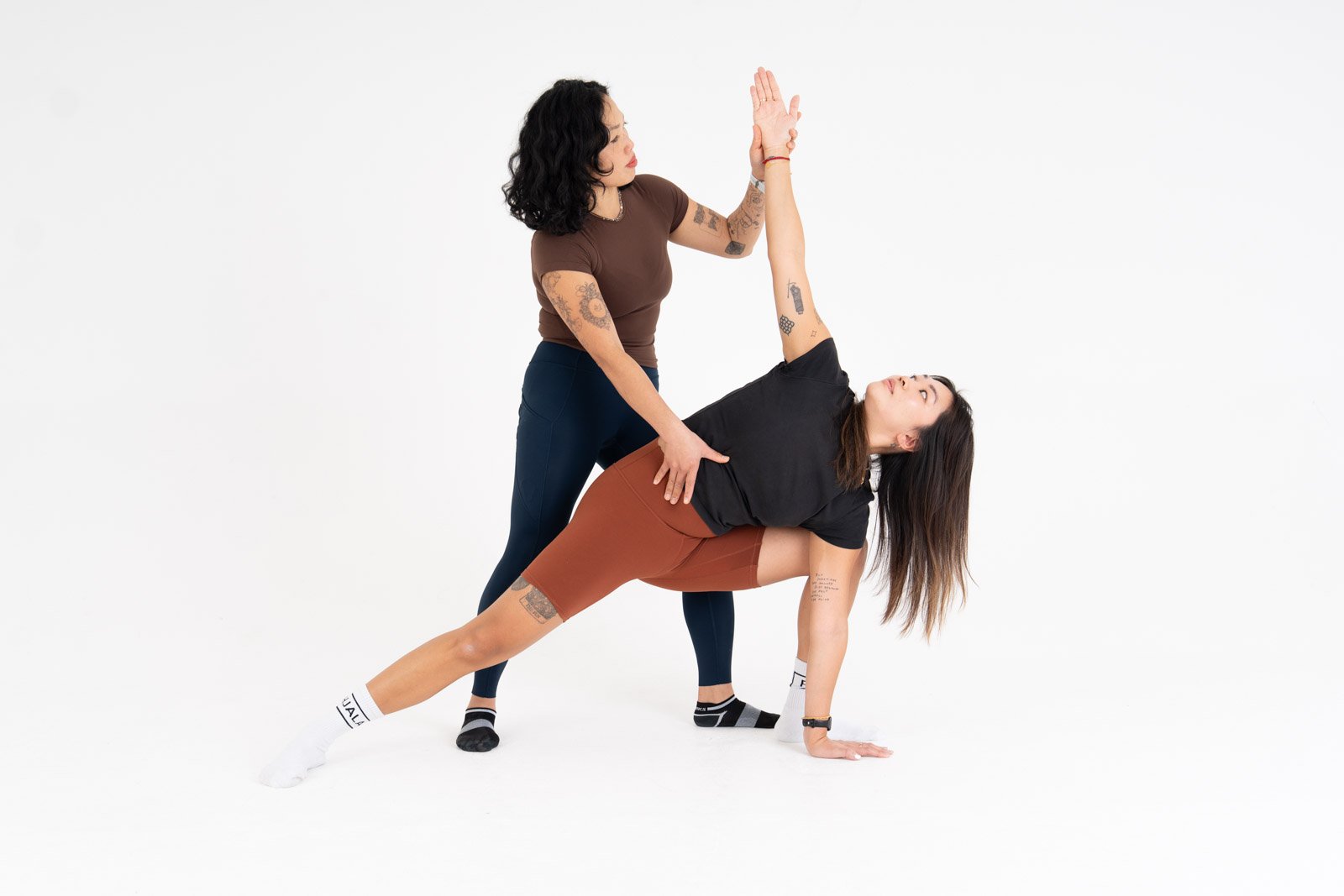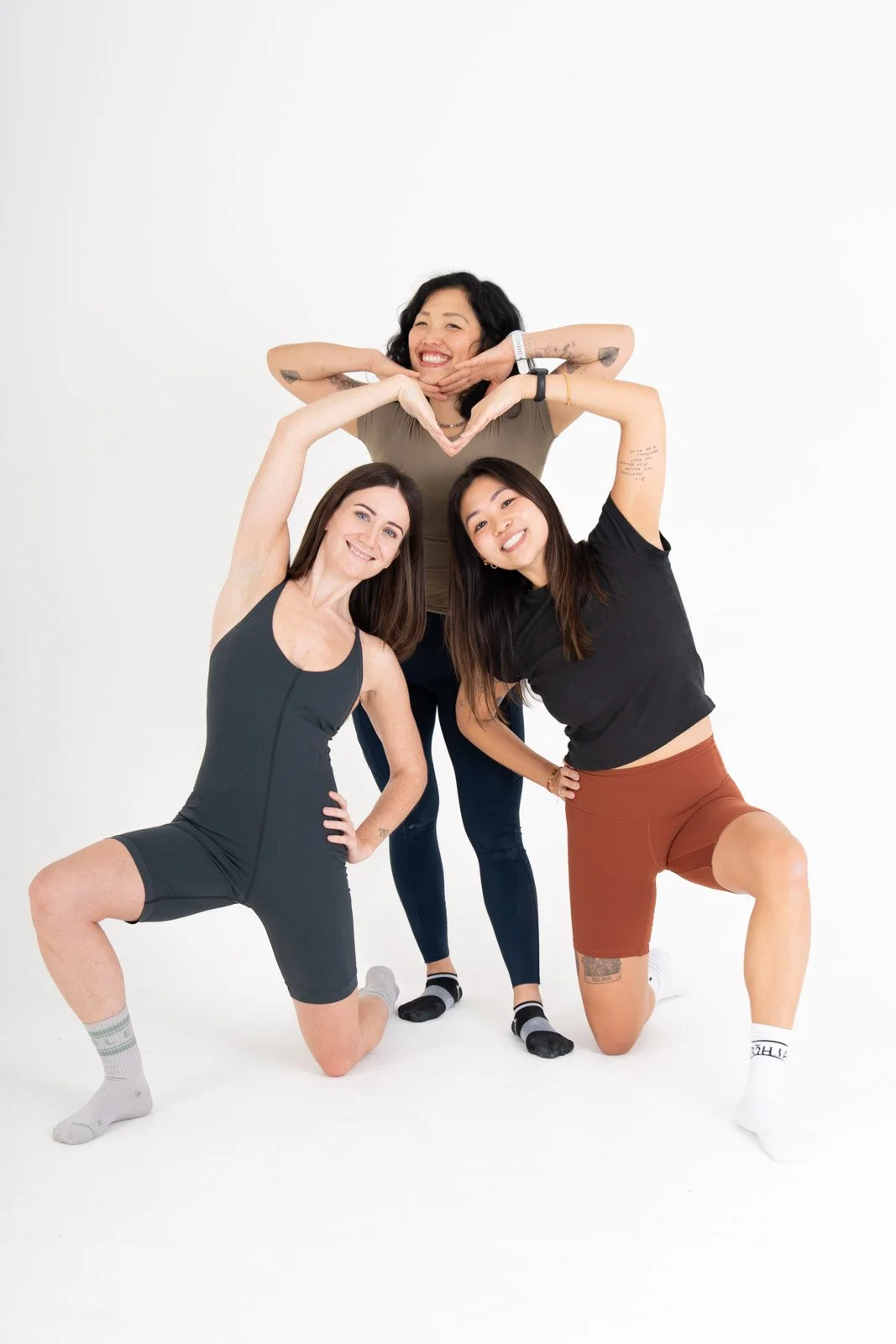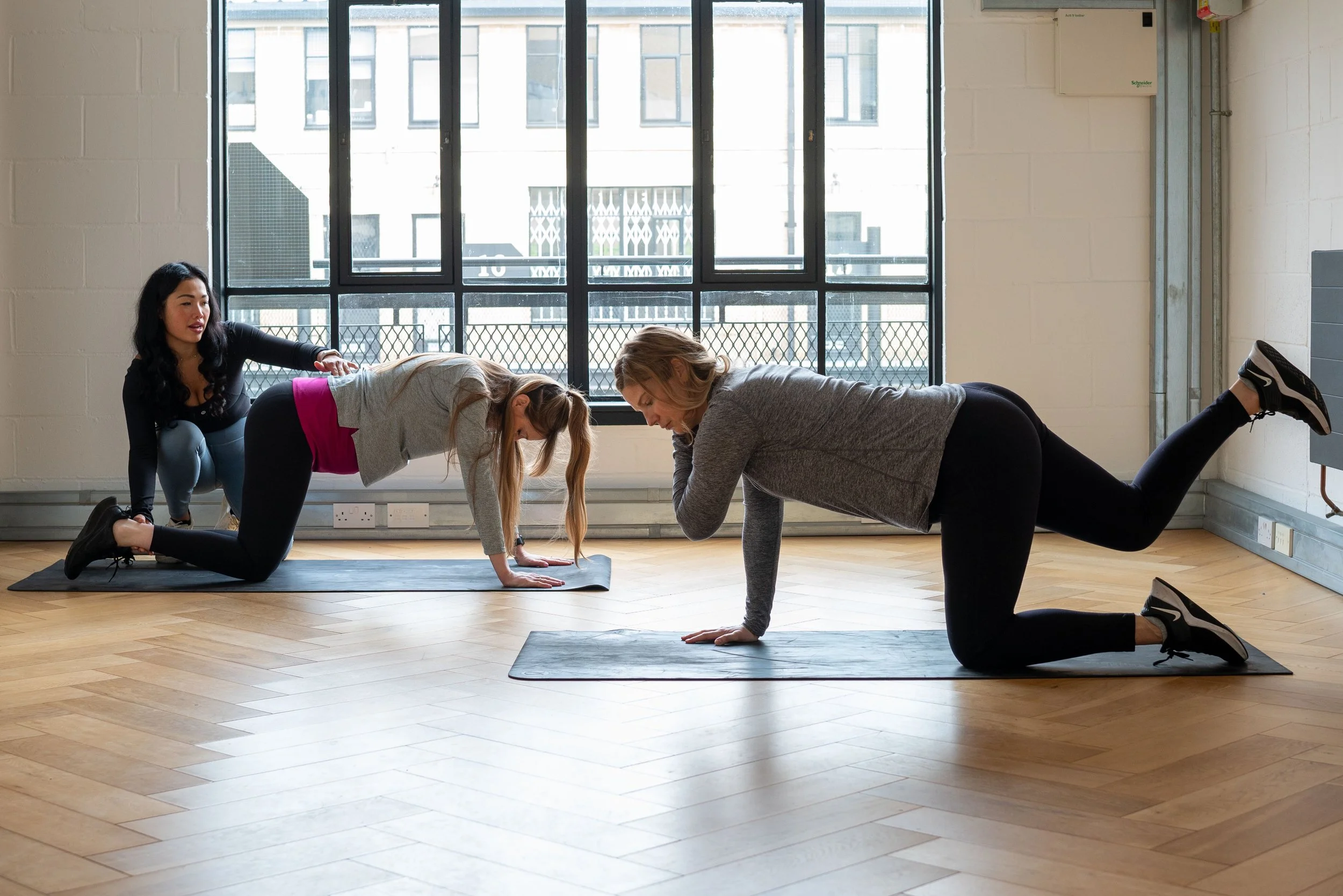
PILATES IN ISLINGTON
Pilates - Where Strength Meets Serenity
Looking for a Pilates Instructor in Islington?
Unlock the Power of Pilates with us. Pilates is not just another exercise routine; it's a holistic approach to fitness that can positively impact your body and mind. We can help you to discover the incredible benefits of this transformative exercise method by focusing on your core strength, flexibility, and overall body conditioning. This will help you to enhance your overall well-being.
What is Pilates?
Whether you're seeking a full-body workout , rehabilitation from an injury in Islington, or simply looking to enhance your fitness level. Our Pilates session offers a comprehensive approach to exercise that can benefit people of all ages and fitness backgrounds.
-
Pilates is a physical fitness system developed by Joseph Pilates in the early 20th century. It is a method of exercise that focuses on building strength, flexibility, and body awareness through controlled and precise movements. Pilates exercises target the deep muscles of the abdomen, back, and pelvis, collectively known as the core muscles. By emphasising core strength, Pilates helps improve posture, balance, and overall body alignment.
-
It is the focus on quality over quantity. Movements are executed with precision and control, rather than relying on repetitive or excessive motion.
Pilates workouts are adaptable and can be modified to accommodate different fitness levels and specific needs, making it suitable for a wide range of individuals, from beginners to professional athletes.
-
Pilates is performed on specialised equipment, such as the reformer, cadillac, and mat, as well as using various props such as resistance bands, balls, and rings.
The exercises in Pilates are designed to engage both the mind and body, incorporating elements of concentration, breath control, and flowing movements.
Why do Pilates?
Pilates has many health benefits for the body and the mind, which is why many of our clients practise it. The following are many advantages of include Pilates in your exercise regimen.
-
Pilates is renowned for its focus on developing core strength. By strengthening the deep abdominal muscles, back muscles, and pelvic floor, Pilates helps improve stability, posture, and overall body alignment.
-
Pilates incorporates stretching exercises that help improve flexibility and joint mobility. Increased flexibility can enhance athletic performance, prevent injuries, and promote better range of motion in daily activities.
-
Pilates targets all major muscle groups, leading to improved muscle tone and strength. By engaging both small and large muscle groups, Pilates helps create long, lean muscles and a more sculpted appearance.
-
The emphasis on proper alignment in Pilates exercises helps improve posture. By strengthening the core and lengthening the spine, Pilates promotes better posture, reduces muscle imbalances, and decreases the risk of developing poor postural habits
-
Pilates focuses on balanced muscle development, flexibility, and body alignment, making it an effective tool for injury prevention and rehabilitation. It can help correct muscle imbalances, improve movement patterns, and aid in the recovery from injuries or surgeries.
-
Pilates emphasises mindful movement, breathing techniques, and body awareness. It promotes a strong mind-body connection, enhancing focus, concentration, and overall mental well-being.
-
The combination of controlled movements, breath work, and mindfulness in Pilates helps reduce stress and promote relaxation. It can serve as a form of stress relief and an opportunity to unwind from the demands of daily life.
-
Pilates exercises challenge balance and coordination, leading to improvements in these areas. Enhanced balance and coordination can benefit daily activities, sports performance, and overall physical confidence.
-
Pilates is often utilised as a form of rehabilitation for various conditions, including back pain, joint issues, and postural imbalances. The gentle and low-impact nature of Pilates exercises makes it suitable for individuals seeking pain management and rehabilitation.
-
Regular Pilates practice promotes overall physical and mental well-being. It can increase energy levels, improve sleep quality, boost self-confidence, and foster a sense of overall wellness and balance.
PREGNANCY and Postnatal Pilates precautions
Postnatal Pilates
-
Postnatal Pilates offers several benefits for new mothers as they navigate the postpartum period and regain strength and fitness. Here are some key benefits of practicing Postnatal Pilates:
Core Strength and Stability: Pregnancy and childbirth can weaken the core muscles, including the abdominal and pelvic floor muscles. Postnatal Pilates focuses on reactivating and strengthening these muscles, promoting core stability and restoring the strength and support of the abdominal and pelvic area.
Pelvic Floor Rehabilitation:
The pelvic floor muscles undergo significant strain during pregnancy and childbirth. Postnatal Pilates includes specific exercises to rehabilitate and strengthen the pelvic floor, helping to improve bladder control, reduce the risk of pelvic floor dysfunction, and support the organs in the pelvis.
Restoring Posture and Alignment Pregnancy and breastfeeding can cause postural changes and muscular imbalances. Postnatal Pilates helps restore proper posture and alignment by targeting the muscles responsible for maintaining an upright posture. This can alleviate back, neck, and shoulder discomfort commonly experienced postpartum.
Improving Diastasis Recti
Diastasis recti is the separation of the abdominal muscles that can occur during pregnancy. Postnatal Pilates includes exercises that focus on closing the gap and restoring the integrity of the abdominal muscles. This helps improve core strength, flatten the abdominal area, and promote better functional movement.
Overall Strength and Muscle Tone
Postnatal Pilates incorporates exercises that target the major muscle groups, helping new mothers regain overall strength and tone. By gradually increasing resistance and intensity, it facilitates the rebuilding of muscle strength without straining the body.
Increased Energy and Vitality
The postpartum period can be physically and emotionally demanding. Postnatal Pilates promotes blood circulation, releases endorphins, and helps new mothers feel energised and revitalised. The combination of gentle movements, deep breathing, and mindful focus can boost mood and overall well-being.
Stress Relief and Relaxation: Caring for a newborn and adjusting to the demands of motherhood can be stressful. Postnatal Pilates provides a dedicated time for self-care and stress relief. The focus on controlled breathing and mindful movement helps reduce stress, increase relaxation, and promote a sense of calm.
Postpartum Recovery and Weight Management
Postnatal Pilates supports the body's healing process and aids in postpartum recovery. By gradually reintroducing physical activity, it helps improve circulation, tone the muscles, and assist in the restoration of pre-pregnancy body shape. Additionally, it can contribute to healthy weight management postpartum.
Bonding and Social Support
Participating in Postnatal Pilates classes or group sessions can provide an opportunity for new mothers to connect with others who are going through a similar phase of life. It offers a supportive environment to share experiences, exchange tips, and build a sense of community.
It's essential to consult with your healthcare provider before starting any exercise program after giving birth. They can provide personalised guidance, consider any specific postpartum considerations, and ensure that Postnatal Pilates is safe and appropriate for you. Start gradually and listen to your body, allowing for proper rest and recovery as needed.
-
If you're considering postnatal Pilates in Islington, here are some advice and recommendations to keep in mind:
Consult with Your Healthcare Provider
Before starting any exercise program after giving birth, it's important to consult with your healthcare provider. They can assess your individual situation, consider any specific postpartum considerations, and provide guidance on when it's safe to begin exercising.
Choose a Qualified Instructor:
Look for a certified Pilates instructor who has experience working with postnatal clients. They should have knowledge of postpartum recovery, diastasis recti, and pelvic floor health to provide appropriate modifications and guidance during your sessions.
Start Gradually:
Ease into postnatal Pilates gradually, especially if you're new to Pilates or haven't exercised during pregnancy. Begin with gentle exercises that focus on restoring core strength and pelvic floor function. Listen to your body and only progress to more challenging exercises as you feel comfortable and ready.
Focus on Core and Pelvic Floor:
Postnatal Pilates emphasises rebuilding core strength and rehabilitating the pelvic floor. Incorporate exercises that target the deep abdominal muscles, obliques, and pelvic floor muscles. This will help restore stability, improve posture, and address any issues like diastasis recti or pelvic floor dysfunction.
Be Mindful of Diastasis Recti:
If you have diastasis recti (separation of the abdominal muscles), it's important to modify your Pilates exercises accordingly. Avoid exercises that put excessive pressure on the abdominal area or cause a bulging sensation. Work with your instructor to select exercises that promote healing and gradually close the gap.
Pay Attention to Pelvic Floor Health
Postnatal Pilates can aid in rehabilitating the pelvic floor muscles, but it's important to be mindful of your pelvic floor health. Avoid exercises that place excessive strain or impact on the pelvic floor, such as high-impact movements or heavy lifting. Focus on gentle activation, coordination, and relaxation of the pelvic floor muscles.
Modify as Needed
Every postpartum journey is unique, and your body may have different needs and limitations. Modify exercises as necessary to accommodate any discomfort, pelvic floor concerns, or physical changes you're experiencing. Your instructor can provide modifications and alternatives to ensure a safe and effective workout.
Listen to Your Body
As a new mother, it's crucial to listen to your body's cues and respect your limits. Take breaks when needed, stay hydrated, and prioritize rest and recovery. If any exercises cause pain or discomfort, stop and consult with your instructor or healthcare provider.
Incorporate Mindfulness and Breathing
Postnatal Pilates offers an opportunity to reconnect with your body and promote relaxation. Focus on mindful movements, deep breathing, and engaging the mind-body connection. This can help reduce stress, enhance relaxation, and improve overall well-being.
Gradually Increase Intensity
As you regain strength and feel more comfortable, gradually increase the intensity and challenge of your postnatal Pilates workouts. Work with your instructor to progress to more advanced exercises and incorporate additional resistance or props, as appropriate for your postpartum recovery.
Remember, postnatal Pilates is a gradual process, and it's important to be patient and kind to yourself. Give your body time to heal and recover, and celebrate each milestone along the way. If at any point you have concerns or questions, consult with your healthcare provider or a qualified Pilates instructor.
-
It is crucial to regain your understanding of how to engage the transverse abdominis, i.e., the muscle group that allows you to “corset” your midsection. When you engage this deep layer of abdominals, you’re able to support your torso and back, which will lead to safer, more efficient movement.
Examples of effective Postnatal weight exercises include: Footwork; Arm work; exercises with your legs in the straps like Frogs; Pulling Straps while seated on the Long Box; Rowing; Mini Swan; Chest Expansion; and Side-Lying work.
-
If you're considering prenatal Pilates, it's important to consult with your healthcare provider before starting any exercise program during pregnancy. Once you have the green light, here are some advice and considerations for practicing prenatal Pilates.
Seek a Qualified Instructor
Look for a certified Pilates instructor who specialises in prenatal Pilates or has experience working with pregnant women. They will have the knowledge to modify exercises appropriately and ensure your safety throughout the sessions.
Communicate with Your Instructor
Inform your instructor about your pregnancy and any specific concerns or limitations you may have. This will allow them to tailor the exercises to your needs and make necessary modifications as your pregnancy progresses.
Prioritise Safety and Comfort
During pregnancy, your body undergoes numerous changes, so it's essential to prioritise safety and comfort. Avoid exercises that put pressure on your abdomen or involve lying flat on your back for an extended period. Modify positions as needed to accommodate your growing belly and maintain stability.
Focus on Core Strength and Stability
Prenatal Pilates can help strengthen your core muscles, which are important for supporting your growing uterus and maintaining good posture. Exercises that target the deep abdominal and pelvic floor muscles can be particularly beneficial.
Modify Intensity and Duration
As pregnancy progresses, you may need to modify the intensity and duration of your Pilates sessions. Listen to your body and take breaks as needed. Avoid overexertion and remember that the goal is to maintain fitness and support your changing body rather than pushing yourself to new limits.
Stay Hydrated
Drink plenty of water before, during, and after your prenatal Pilates sessions to stay hydrated. Proper hydration is crucial for both you and your baby's well-being.
Pay Attention to Your Breathing
Pilates places emphasis on proper breathing techniques. Focus on deep, diaphragmatic breathing to provide optimal oxygenation and relaxation. Avoid holding your breath during exercises.
Be Mindful of Relaxin Hormone
During pregnancy, the hormone relaxin is released, which can make your joints more flexible and prone to injury. Be mindful of your range of motion and avoid excessive stretching or pushing beyond your limits.
Listen to Your Body
Every pregnancy is different, and what feels comfortable or appropriate for one person may not be the same for another. Listen to your body's signals and modify or skip any exercises that don't feel right for you.
Regularly Check In with Your Healthcare Provider
Throughout your pregnancy, continue to attend regular check-ups with your healthcare provider. Inform them about your Pilates practice and discuss any concerns or changes you may experience.
Remember, prenatal Pilates should be approached with caution and under proper guidance. The goal is to maintain a healthy level of fitness, support your changing body, and promote overall well-being during pregnancy.
Prenatal Pilates
Precautions & Modification
-
If you’re unable to work with a postnatal exercise specialist, it’s vital to understand which exercises are inappropriate for the post-baby body. This will come in handy when you opt for a quickie mat workout while your baby naps!
-
Exercises that might be counterproductive for the postnatal body include anything that causes extra intra-abdominal pressure like planks, push-ups and sit-ups.
If you enjoy lifting weights to supplement your Pilates, opt for lighter weight, especially while squatting or doing deadlifts.
Avoid back-extension exercises like Swan and Swimming right off the bat. The majority of new mothers have a forward kyphotic (slumped) posture, the result of holding and feeding baby and having full breasts. Before you engage in any form of back extension, focus on opening your chest and shoulders. That way, you’ll reap the benefits of back-bending without injuring your body.
Pilates FAQs
-
A: While Pilates and yoga share some similarities, such as focusing on mind-body connection and improving flexibility, they are distinct practices.
Pilates emphasises core strength and stability, using controlled movements and specialised equipment. Yoga, on the other hand, incorporates a combination of physical postures, breathing exercises, and meditation to promote overall well-being and spiritual growth.
-
A: Yes, Pilates is suitable for people of all ages and fitness levels. Pilates exercises can be modified to accommodate individual needs and limitations. However, if you have any specific medical conditions or injuries, it's recommended to consult with a healthcare professional before starting a Pilates program.
-
A: While Pilates can be performed on specialised equipment like reformers and cadillacs, it is not a requirement. Mat Pilates, which involves performing exercises on a mat, is equally effective and requires minimal equipment. Some props like resistance bands, stability balls, or Pilates rings may be used to add variety and challenge to the workouts.
-
A: The frequency of Pilates practice depends on individual goals and preferences. Ideally, aim for at least two to three sessions per week to experience noticeable benefits. Consistency is key in Pilates, so finding a routine that works for you and sticking to it is important.
-
A: While Pilates can contribute to weight loss indirectly by increasing muscle tone, improving metabolism, and promoting overall body strength, it is not primarily a cardiovascular exercise. Pilates is more focused on building core strength, flexibility, and body awareness. For weight loss goals, combining Pilates with aerobic exercises and maintaining a balanced diet is recommended.
-
A: Absolutely not! Pilates is for both men and women. In fact, Pilates was originally developed by Joseph Pilates, a man, and it has been embraced by people of all genders around the world. The benefits of Pilates, such as improved core strength, flexibility, and body alignment, are beneficial for everyone.
-
A: Yes, Pilates can be beneficial for individuals dealing with back pain. The focus on core strength and alignment helps support the spine and can alleviate back discomfort. However, it is essential to consult with a healthcare professional or a qualified Pilates instructor who can guide you with specific exercises and modifications tailored to your condition.
-
A: The time it takes to see results from Pilates varies from person to person. With consistent practice, many people start noticing improvements in strength, flexibility, and posture within a few weeks. However, significant changes may take longer, depending on individual factors such as fitness level, dedication, and frequency of practice.
-
A: Pilates can be modified and adapted to suit the needs of pregnant women. Prenatal Pilates classes or specialized instructors can guide you through safe and appropriate exercises that focus on maintaining core strength, improving posture, and supporting the changing body during pregnancy. As always, it is crucial to consult with your healthcare provider before starting any exercise program during pregnancy.






